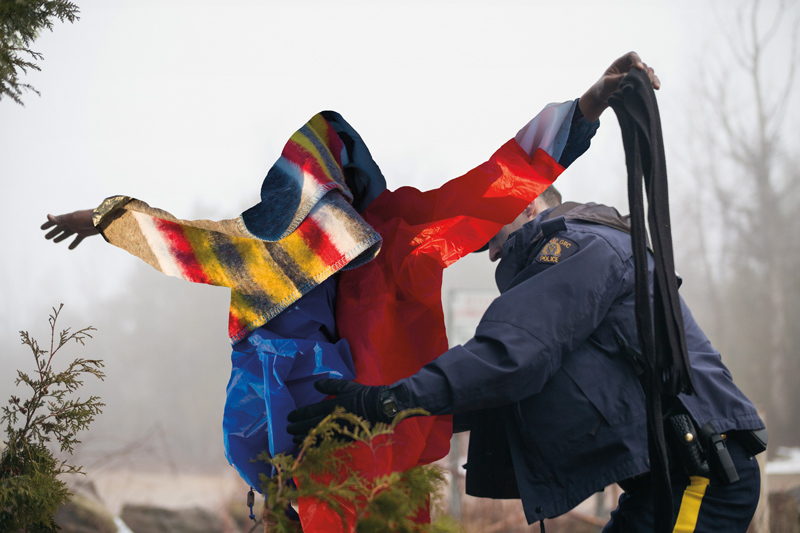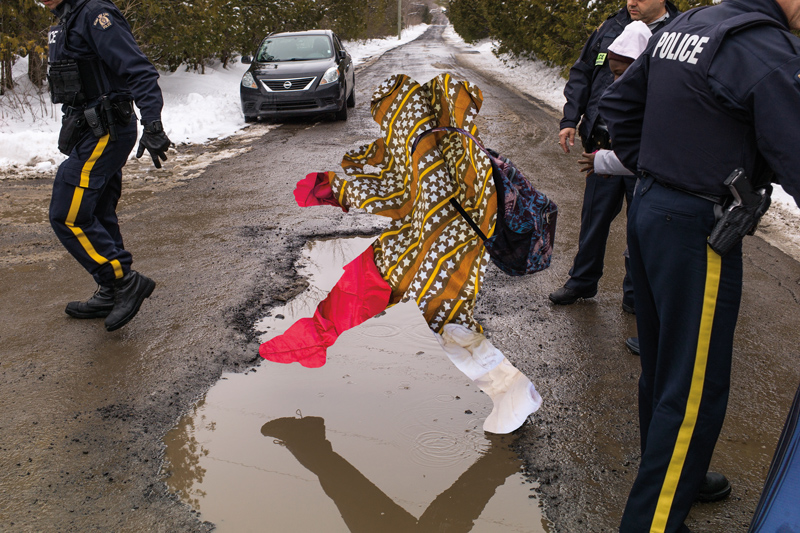[Fall 2018]
By Sophie Bertrand
Thanks to their inherent power, images may function to inform or to reinforce prejudices. For a number of years, photographer Michel Huneault has been concerned with deconstructing preconceived ideas about migratory issues. Each of his new series builds on the previous one, making it easier to understand both his artistic approach and the scope of the migration phenomenon. In 2017, he worked on the multimedia project Roxham,1 named for the road in part of the Montérégie region adjacent to the United States that has become the hope for a better future for thousands of asylum seekers who cross the Canadian border there as “irregulars.” Protectively and ethically, Huneault chose to preserve the anonymity of these people by applying to their silhouettes a texture from his images made in 2015 during the refugee crisis in Europe. With this visual choice, he weaves an intercontinental thread between these two migrations and points toward the urgency of reconsidering this political imbroglio and the history of migratory movements.
Situating his approach between documentary photography and visual art, Huneault adds audio to his long-term project and experiments with virtual reality. In the immersive narrative created for newspaper readers, gallery visitors, viewers in their living rooms, and VR explorers, he proposes that we take the reins of the documentary for an instant, but also that we become witnesses or border guards. The binaural soundtrack plunges us into the confusion that rules in exchanges between the RCMP and asylum seekers, who navigate among the application of protocol, desperation, and emotion.
SOPHIE BERTRAND: What was the genesis of the Roxham project, and how was the idea of creating this connection between the two continents born?
MICHEL HUNEAULT: In Roxham, the first attempt at crossing the border that I witnessed was by a pregnant woman from Nigeria who never dared to cross and was turned back by an American agent. That made up my mind. I wanted to know whether, in relation to the laws in force, other attempts to cross would inevitably fail or if the situation could evolve. There were many images of RCMP agents taking migrants by the hand. I had just seen an exception that seemed relevant to pursuing the debate. I contacted editorial boards, specifying up front that I was uneasy with breaking the woman’s anonymity. My professional experience had led me to understand our responsibility to asylum seekers not to divulge their identity. Due to my sense of morality, I kept to that condition, and that certainly impeded publication of my work at the beginning.
So, I started to do some visual research, cutting out silhouettes, placing flat planes of colour. I thought again of the migrant crisis in Europe; I knew that there was a connection to Roxham, that it was part of the same general migratory movement. In Europe, there were many assistance groups, citizens who offered food, tents, and blankets. As a photographer, one is drawn to the textures. So, I had lots of close-ups and I made a selection. It worked. It both preserved people’s anonymity and maintained a connection between the two phenomena.
When it comes to shapes, superimposition of images, and immersive videos, I had already experimented quite a bit with my previous project, Monnaie d’échange.2 This might seem removed from my work on migrants, but for me it’s a big continuum.
How do these two humanitarian crises resemble or differ from each other?
Unlike in Roxham, the migratory crisis in Europe is taking place in public places: train stations, highways, and so on. This daily contact with migrants changes the opinion of the local population. But here, it isn’t a crisis. What’s fascinating is that everyone uses this small road.
Is your approach the same when you work abroad and in Quebec?
The most interesting projects are the ones I’ve done close to home due to the proximity, the access, and the frequency of visits possible. In Europe, I was a photographer. Here, I’m also a citizen, a former humanitarian worker, a documentary maker. The visitor who sees Roxham becomes all of that at once, but also the authority, the government. The experience offered with Roxham makes us feel sometimes like a witness, sometimes a voyeur, sometimes an RCMP officer, and sometimes an asylum seeker. It’s very similar to my own experience on site.
Your work is often situated at the line between documentary and contemporary photography. What are the essential criteria for preserving the documentary value of a work without drifting toward “artwork”?
The line isn’t known; there are no models or rules. I’m very demanding with myself and I have to be comfortable with what I’m offering. It has to be justified! Most of my visual proposals are very simple, even though the reflection may be complex. Readers or spectators have to see themselves in them and not feel manipulated.
I’ve noticed an evolution in each of my series, and I perceive more and more of a cinematographic or pictorial influence in them. I’m beginning to keep this dimension in my new projects. This has led me to do research on the interpretation of painting movements in modern art in relation to its epoch, its history. I’m looking for new forms of representation that are current today. In Roxham, certain textures refer to geographic shapes. This visual form first emerged in relation to an ethical and moral responsibility: I wanted this work to reestablish the nuance between the terms “irregulars” and “illegals,” which are applied without distinction to migrants, and bring to light the Safe Third Country Agreement.3
As I’ve said, I didn’t want to show individuals. That’s what makes people look at the pictures for a much longer time: they try to imagine the person, they observe the details in the textures, they look for meaning. Nor do my legends tell them about the migrants’ countries of origin. And the fact that they don’t have access to these individuals’ skin colour or clothing helps to get rid of judgments and prejudices. That was a really great discovery that resulted from this project. Finally, it is very important for me that my work be done as much in the journalistic sphere as in the artistic sphere in order to broaden the debate.
The photography exhibition is already an immersive installation with images and the binaural audio experience. What is the importance of sound in this project, and what more does virtual reality contribute?
I’ve always used immersive elements in my practice. It’s important for me to confront my photography with other forms of documentation: it strengthens the validity or honesty of the photographs. As a spectator, I want to hear the sound. In Roxham, the exhibition experience is raw: we leave spectators with the photographs and the emotion of the sound (the sound is identical in the VR experience). For the VR piece, with collaborators Maude Thibodeau (interactive designer) and Chantal Dumas (sound designer), we wondered how we could bring spectators into the situation, make them feel the confusion and emotion. But the virtual reality production quickly raises the question of how one can use video-game codes without being limited by them, without it becoming merely a video game. We wanted to refer to elements of geographic borders while keeping things simple and accessible, and we took care to humanize the silhouettes by putting them in shadow; the entire team did a really fine, careful job! The sounds are also as raw as possible, and we kept a few shutter-clicks to remind spectators of the photographer’s presence. The narration also provides a guide at times in the different kinds of crossings. There was a real desire to explore and to reach out to a new public to make them aware of these social issues. It’s interesting to see people’s different reactions to the virtual environment and the exhibition. The VR piece is also more accessible, via an online application on the NFB site, and it gives access to more moments than does the photography exhibition.
Louise Arbour, who is the UN Special Representative for International Migration, knows and appreciates this work. How does her recognition validate your project?
Migration, the idea of nationality, and the idea of borders have to be rethought. We are facing a real limit to our vocabulary and our international and legal tools, which were made in another era and no longer correspond at all to current needs. Through collaborations, I’ve been working on these ideas for a number of years. We have had long discussions with Louise Arbour about these migratory issues. She is working on redefining these issues and developing a basis for a new international agreement. This reinforces my idea that my work offers a relevant form of documentation and that it’s important to do this work. Translated by Käthe Roth
2 In 2016, Huneault worked collaboration with journalist Sarah R. Champagne on the personal and economic relations generated by diasporas around the world, See michelhuneault.com/3/index.php/migration/monnaie-dechange/.
3 See the glossary linked to the Roxham project at http://mediaspace.nfb.ca/epk/roxham/.
Sophie Bertrand is a Montreal-based photographer and independent photography writer. Her personal work revolves around the themes of memory and transmission. In 2017, she undertook a diploma in museology and art display at UQAM in order to develop curatorial projects in the field of photography. She is a member of the Stock Photo collective (Montreal) and of Studio Hans Lucas (Paris). sophie-bertrand.com
Michel Huneault is a photographer interested in issues associated with development, trauma, and migrations. His series won the Dorothea Lange– Paul Taylor Prize in 2015 and then was published by the Dutch publisher Schilt. In 2016, his project Post Tohoku, on the aftermath of the tsunami in Japan, was nominated for the Prix Pictet 7 and won the Prix Antoine-Desilets. In the same year, he received a Travers grant to continue his research on migratory issues. Huneault lives in Montreal. michelhuneault.com
Roxham is being presented at Centre Phi until August 12, 2018, in an exhibition of photographs and sound and virtual reality as part of Particules d’existence. An interactive application is also available on the National Film Board website. The Roxham/VR project was also presented at VR Arles Festival 2018 during the Rencontres de la photographie in Arles, France.
[ Complete issue, in print and digital version, available here: Ciel variable 110 – MIGRATION ]
[ Individual article in digital version available here: Michel Huneault, Roxham – Sophie Bertrand, An Intersubjective Artwork for Rethinking the Phenomenon of Migrations ]



